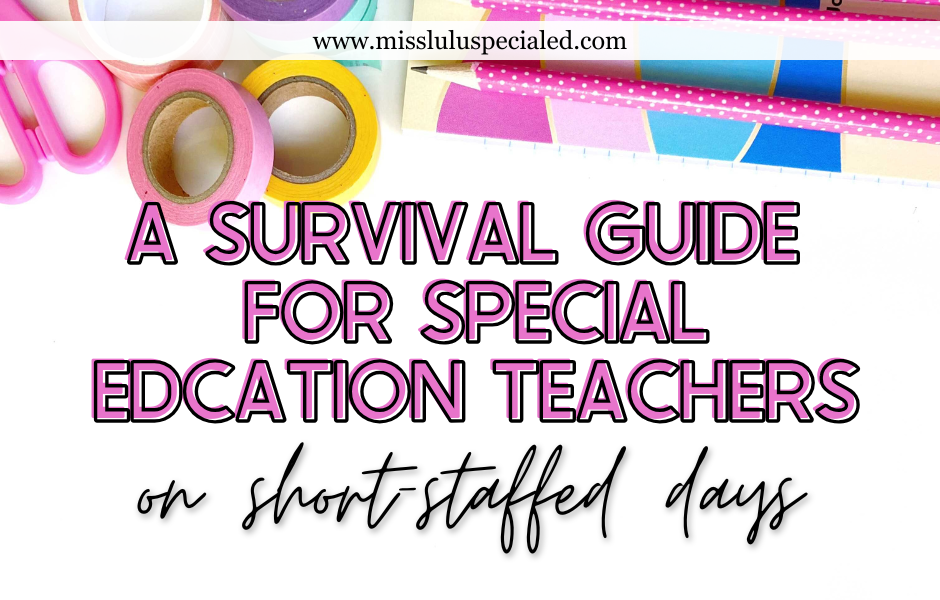PREPARING TO TEACH EXTENDED SCHOOL YEAR (ESY)
- Laura

- Jun 11, 2023
- 3 min read
Updated: Jun 20, 2023
As a teacher, summertime is usually a long break from the classroom, but for some students with disabilities, the extended school year is a necessity. For those special education teachers tasked with teaching during extended school year (ESY), it can be a daunting experience. What is the purpose of ESY, what skills should I teach, and how do I create a schedule? Let’s talk about the essential steps for preparing to teach ESY for students with disabilities.

Gather materials from teachers
As an ESY teacher, you may have students that are not typically in your classroom. Make sure to talk with their current teachers about their curriculum, progress, and other important need-to-know information. I always suggest that teachers go observe students before the end of the school year if possible. You want to be prepared to address challenging behaviors or situations that may occur.
In addition to talking with current special education teachers, you can request that the current teacher provide data sheets and materials for the student. If the student has a communication device, make sure to arrange for it to come to the location ESY is being held. If the student has a specific behavior plan or visual support, ask for copies. It's important that ESY looks similar to the school year for students so that they are not trying to generalize skills in a completely new environment and instead are focused on maintaining the skills they have gained throughout the school year.
When I did not teach ESY for my students that qualified, I sent the ESY teacher a quick tip sheet like this.

Create folders for student data
During ESY, I simplify my data collection system by creating student folders instead of binders. Each student has a section for math, reading, and other goal areas with a copy of their data sheets. Then, I send this back to their special education teacher at the end of the ESY session (if I am not their regular teacher). Make sure to check each student's ESY paperwork to see which IEP goals have qualified for ESY services- you may not need to take data on every single goal area like you do during the school year.
Decide on whole class instruction
Think about how you want your ESY session to run. You'll of course need time to work in small groups or 1:1 with students to address goals. But you also may want to throw in some whole class instruction or large groups. Maybe you want to start the day with calendar or end with a large group read aloud. When I teach ESY, I like to have a fun summer theme each week and do related activities, like an art project, read aloud, science, etc., during a large group period.
Create a schedule
ESY is generally a shorter day than the typical school day. You'll want to set up a schedule that covers all the skills that students qualify for, including related services. I like to do a few different blocks to address IEP goals.
I also recommend getting students outside for a little while each day is possible. In elementary settings, this may be a quick recess session. In secondary settings, maybe you can plan some outdoor activities or community based instruction. The last few summers I taught ESY, we went on 2-3 CBI trips and it was a blast!

Once you've decided on what large group activities you want to include, plug them into your schedule.
Here is a sample schedule for a 3 hour session that I give my teachers.


Remember the purpose
Extended School Year services must be provided if the IEP team determines that the services are necessary for the provision of FAPE. Not all students are eligible or need ESY services. ESY services are specialized instruction or related services that are a part of a student's IEP. This means that you can't just teach whatever fun activities you want. You must ensure that you are providing specially designed instruction that is indicated in the IEP. These specific eligible goals and skills will be identified by the IEP team.
The main purpose of ESY is to help students maintain skills and minimize regression in the progress they have made throughout the school year. As an ESY teacher, you are tasked with minimizing the regression of a skill to shorten the time needed to gain back the same level of proficiency. It is not to "catch students up" to the level of their peers.
I find it extremely helpful to remember the purpose when going into teaching ESY. You don't want to overwhelm yourself trying to create a fun, summer school program that covers all the things! Stick to what students need and are qualified for, and remember that you are not trying to get them ahead, you are simply helping them maintain the skills they currently have.
With the right preparation, you will be able to build a successful extended school year program. Have fun!











Comments